三年级下册英语开学第一课
- 格式:pptx
- 大小:234.83 KB
- 文档页数:9
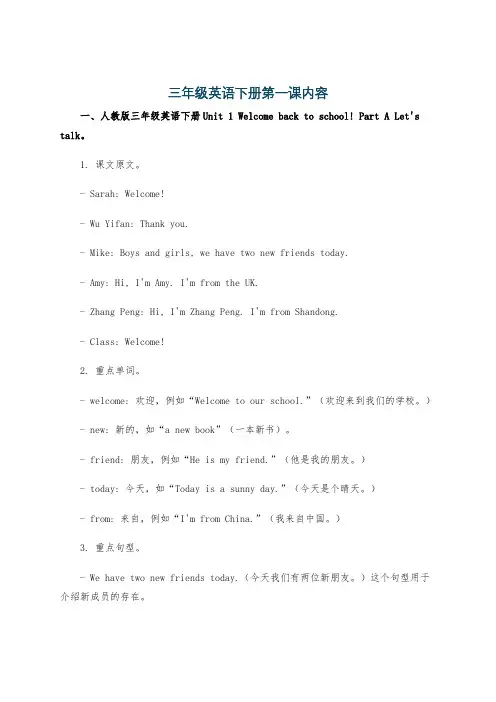
三年级英语下册第一课内容一、人教版三年级英语下册Unit 1 Welcome back to school! Part A Let's talk。
1. 课文原文。
- Sarah: Welcome!- Wu Yifan: Thank you.- Mike: Boys and girls, we have two new friends today.- Amy: Hi, I'm Amy. I'm from the UK.- Zhang Peng: Hi, I'm Zhang Peng. I'm from Shandong.- Class: Welcome!2. 重点单词。
- welcome: 欢迎,例如“Welcome to our school.”(欢迎来到我们的学校。
)- new: 新的,如“a new book”(一本新书)。
- friend: 朋友,例如“He is my friend.”(他是我的朋友。
)- today: 今天,如“Today is a sunny day.”(今天是个晴天。
)- from: 来自,例如“I'm from China.”(我来自中国。
)3. 重点句型。
- We have two new friends today.(今天我们有两位新朋友。
)这个句型用于介绍新成员的存在。
- I'm... I'm from...(我是……我来自……)这是用于自我介绍,包括自己的名字和来自哪里的句型。
例如在课文中Amy说“I'm Amy. I'm from the UK.”和Zhang Peng说“I'm Zhang Peng. I'm from Shandong.”二、Let's learn部分。
1. 单词。
- UK(the United Kingdom): 英国,例如“He is from the UK.”- Canada: 加拿大,如“She is from Canada.”- USA(the United States of America): 美国,例如“My pen pal is from the USA.”- China: 中国,如“I'm from China. I love China.”2. 文化知识点。
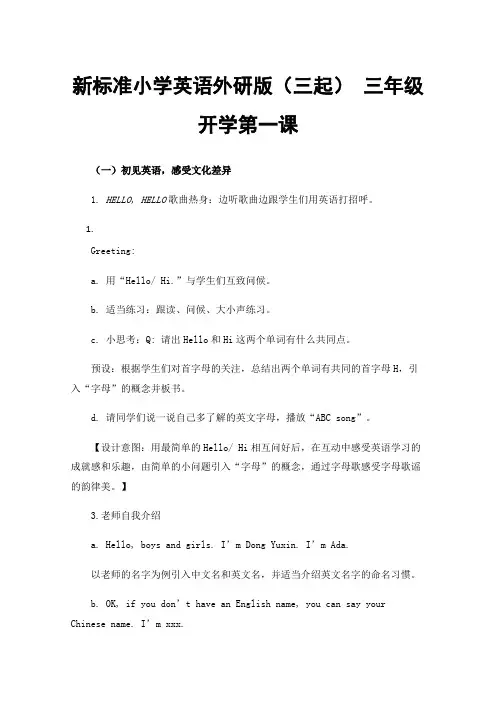
新标准小学英语外研版(三起)三年级开学第一课(一)初见英语,感受文化差异1. HELLO, HELLO歌曲热身:边听歌曲边跟学生们用英语打招呼。
1.Greeting:a. 用“Hello/ Hi.”与学生们互致问候。
b. 适当练习:跟读、问候、大小声练习。
c. 小思考:Q: 请出Hello和Hi这两个单词有什么共同点。
预设:根据学生们对首字母的关注,总结出两个单词有共同的首字母H,引入“字母”的概念并板书。
d. 请同学们说一说自己多了解的英文字母,播放“ABC song”。
【设计意图:用最简单的Hello/ Hi相互问好后,在互动中感受英语学习的成就感和乐趣,由简单的小问题引入“字母”的概念,通过字母歌感受字母歌谣的韵律美。
】3.老师自我介绍a. Hello, boys and girls. I’m Dong Yuxin. I’m Ada.以老师的名字为例引入中文名和英文名,并适当介绍英文名字的命名习惯。
b. OK, if you don’t have an English name, you can say your Chinese name. I’m xxx.c. 刚才很多同学还没有介绍自己的名字,请同桌练习一下小对话。
A: hello/ hi/! I’m ...B: Hi,(二)童谣分享,故事启智1.看图片猜情景,谈感想2.分段播放视频,看视频回答问题。
Q1: What was the first pig’s house made of?第一只小猪用什么造的房子?——The hay(稻草)Q2: What was the second pig’s house made of?第二只小猪用什么造的房子?——The sticks(木棍)Q3: What was the third pig’s house made of?第三只小猪用什么造的房子?——The bricks(砖头)3.孩子们,如果由你来建造一间房子,你想用什么材料呢?预设:学生们肯定也会选择较坚固的材料,为后续小结做准备。
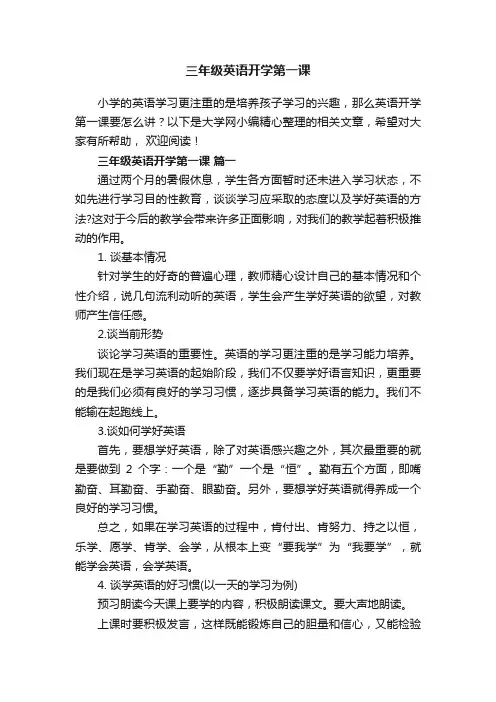
三年级英语开学第一课小学的英语学习更注重的是培养孩子学习的兴趣,那么英语开学第一课要怎么讲?以下是大学网小编精心整理的相关文章,希望对大家有所帮助,欢迎阅读!三年级英语开学第一课篇一通过两个月的暑假休息,学生各方面暂时还未进入学习状态,不如先进行学习目的性教育,谈谈学习应采取的态度以及学好英语的方法?这对于今后的教学会带来许多正面影响,对我们的教学起着积极推动的作用。
1. 谈基本情况针对学生的好奇的普遍心理,教师精心设计自己的基本情况和个性介绍,说几句流利动听的英语,学生会产生学好英语的欲望,对教师产生信任感。
2.谈当前形势谈论学习英语的重要性。
英语的学习更注重的是学习能力培养。
我们现在是学习英语的起始阶段,我们不仅要学好语言知识,更重要的是我们必须有良好的学习习惯,逐步具备学习英语的能力。
我们不能输在起跑线上。
3.谈如何学好英语首先,要想学好英语,除了对英语感兴趣之外,其次最重要的就是要做到2个字:一个是“勤”一个是“恒”。
勤有五个方面,即嘴勤奋、耳勤奋、手勤奋、眼勤奋。
另外,要想学好英语就得养成一个良好的学习习惯。
总之,如果在学习英语的过程中,肯付出、肯努力、持之以恒,乐学、愿学、肯学、会学,从根本上变“要我学”为“我要学”,就能学会英语,会学英语。
4. 谈学英语的好习惯(以一天的学习为例)预习朗读今天课上要学的内容,积极朗读课文。
要大声地朗读。
上课时要积极发言,这样既能锻炼自己的胆量和信心,又能检验自己的发音是否准确。
而且老师特别喜欢上课发言积极的孩子。
听课时,有自己不会读的单词或其他不懂的地方,要勇敢地问老师,或下课后请教同学或老师,把不懂的弄明白。
做作业时,要独立完成,完成作业与独立完成作业有着本质的区别,只有独立完成作业,才能把所学的知识化为己有。
即使是抄写单词或课文,也大有讲究:边认真抄写,边争取掌握所抄内容。
你想,如果能这样,你的学习效率就大大提高了。
订正作业时,一定要及时有效,要用红笔把正确的答案写在下面,甚至可以写两遍,然后请老师或者好同学批改一下。
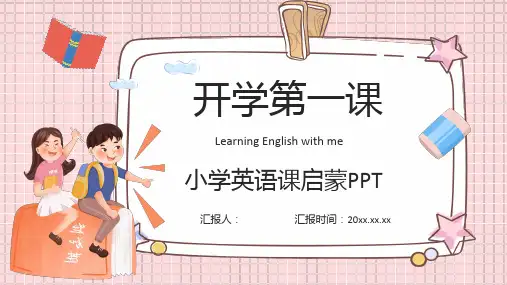

小学英语三年级下册开学第一课教案小学英语三年级下册开学第一课教案【课题名称】《课程纲要》分享【学习目标分析依据】基于学生实际三年级的学生处于第一学段的初期,有强烈的好奇心、求知欲强。
因此在教学时,要从启发兴趣、激发思维入手,学生自己总结学习方法,鼓励畅所欲言,使学生产生学习的愿望,愿意表达自己独特的思想。
【学习目标】1.通过与学生交流课程纲要,了解本学期英语学习的课程内容、课程目标以及课程评价。
2.通过了解教师对学生的评价和学习方法,激发学生自主学习的主动性。
【教学重点】通过学习和老师的讲解了解本学期的教学重点和难点,教学内容和评价方法。
【教学难点】1. 通过课程纲要的分享,了解本学期的教学目标,并了解英语学习中的重点,并养成习惯.2. 围绕《课程纲要》展开讨论,就自己感兴趣的地方进行思考,积极发表自己的见解和建议。
【教学时间】1课时【教学准备】课前学生根据要求“预习要求”自学;教师准备课件。
【评价设计】通过课堂指名说、课堂交流等形式对学生交流情况进行评价。
【学习活动方案】一、谈话导入1、同学们,今天的课堂上老师要带领大家认识一位新朋友,它就像一幅地图一样,能够指引大家在本学期的学习中找准学期目标,理清学习内容、了解学习安排,真正成为学习的小主人,它就是——《课程纲要》。
(板书课题)二、新授1、怎样才能做学习的小主人呢?首先我们要了解本学期的.学习内容。
请大家打开目录,看一看本册书我们总共分为几个单元,附录页又有哪些部分构成?2、那这些内容我们怎么合理安排呢?(PPT出示一单元学习时间安排)3、目录就像路标一样,指引我们了解每单元都有哪些内容,下面我们一同以第一单元为例,一同探讨本单元的话题功能及重点单词类别、句型功能及语音组合。
(出示PPT,指生说)4、请大家打开第二单元,想想这本单元的话题功能及重点单词类别、句型功能及语音组合又是什么呢?(出示PPT,指生说)5、下面我们分成四人小组合作学习,分大组分别完成剩余四个单元?(四人小组合作学习)6、小组汇报(PPT出示)7、同学们,通过刚才大家的学习,我们已经了解了本学期我们要学习的内容和时间安排,那么我们本学期通过学习要掌握哪些本领呢?(PPT出示学习目标)指生读8.为了更好地掌握以上本领,我们又要怎样逐步实施的。
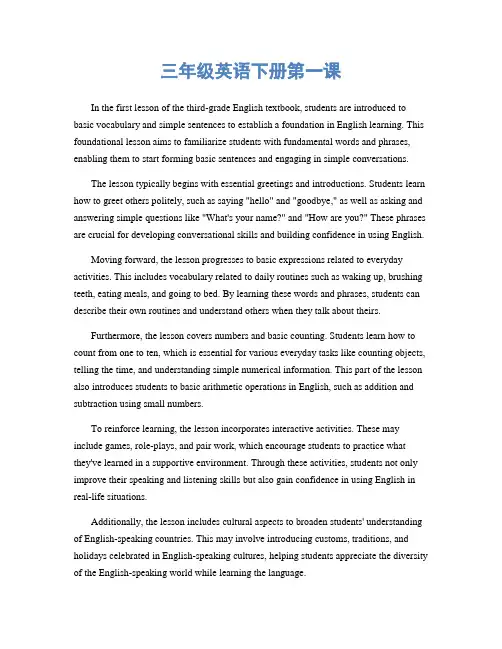
三年级英语下册第一课In the first lesson of the third-grade English textbook, students are introduced to basic vocabulary and simple sentences to establish a foundation in English learning. This foundational lesson aims to familiarize students with fundamental words and phrases, enabling them to start forming basic sentences and engaging in simple conversations.The lesson typically begins with essential greetings and introductions. Students learn how to greet others politely, such as saying "hello" and "goodbye," as well as asking and answering simple questions like "What's your name?" and "How are you?" These phrases are crucial for developing conversational skills and building confidence in using English.Moving forward, the lesson progresses to basic expressions related to everyday activities. This includes vocabulary related to daily routines such as waking up, brushing teeth, eating meals, and going to bed. By learning these words and phrases, students can describe their own routines and understand others when they talk about theirs.Furthermore, the lesson covers numbers and basic counting. Students learn how to count from one to ten, which is essential for various everyday tasks like counting objects, telling the time, and understanding simple numerical information. This part of the lesson also introduces students to basic arithmetic operations in English, such as addition and subtraction using small numbers.To reinforce learning, the lesson incorporates interactive activities. These may include games, role-plays, and pair work, which encourage students to practice what they've learned in a supportive environment. Through these activities, students not only improve their speaking and listening skills but also gain confidence in using English in real-life situations.Additionally, the lesson includes cultural aspects to broaden students' understanding of English-speaking countries. This may involve introducing customs, traditions, and holidays celebrated in English-speaking cultures, helping students appreciate the diversity of the English-speaking world while learning the language.Throughout the lesson, teachers employ visual aids such as flashcards, pictures, and charts to facilitate comprehension and retention of vocabulary. These visual tools help make learning more engaging and accessible, especially for young learners who are still developing their language skills.In conclusion, the first lesson of the third-grade English textbook lays a solid foundation for students' English language learning journey. By focusing on basic greetings, everyday activities, numbers, interactive activities, and cultural insights, the lesson ensures that students not only acquire essential vocabulary and language structures but also develop confidence in using English in practical situations. This structured approach prepares students for further learning and sets the stage for a successful progression in mastering the English language.。
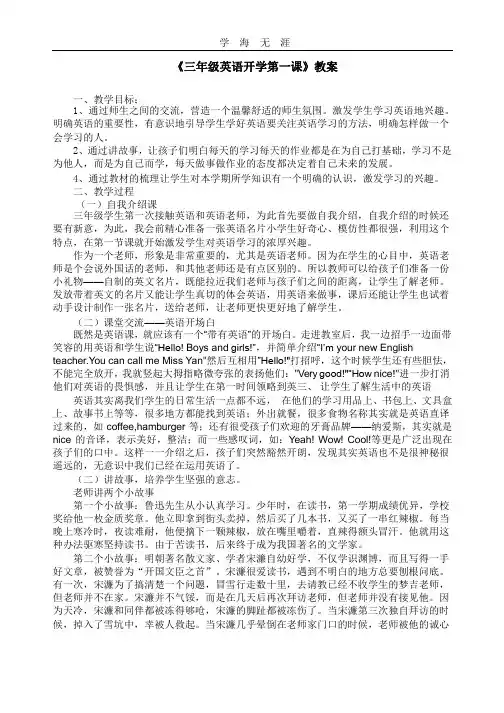
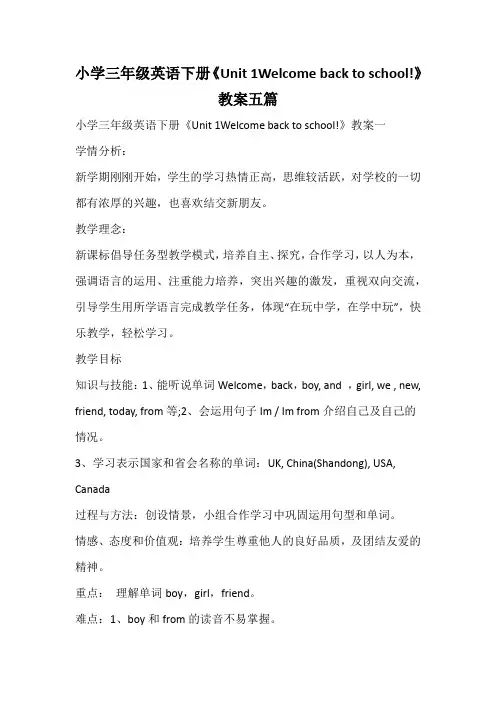
小学三年级英语下册《Unit 1Welcome back to school!》教案五篇小学三年级英语下册《Unit 1Welcome back to school!》教案一学情分析:新学期刚刚开始,学生的学习热情正高,思维较活跃,对学校的一切都有浓厚的兴趣,也喜欢结交新朋友。
教学理念:新课标倡导任务型教学模式,培养自主、探究,合作学习,以人为本,强调语言的运用、注重能力培养,突出兴趣的激发,重视双向交流,引导学生用所学语言完成教学任务,体现“在玩中学,在学中玩”,快乐教学,轻松学习。
教学目标知识与技能:1、能听说单词Welcome,back,boy, and ,girl, we , new, friend, today, from等;2、会运用句子Im / Im from介绍自己及自己的情况。
3、学习表示国家和省会名称的单词:UK, China(Shandong), USA, Canada过程与方法:创设情景,小组合作学习中巩固运用句型和单词。
情感、态度和价值观:培养学生尊重他人的良好品质,及团结友爱的精神。
重点:理解单词boy,girl,friend。
难点:1、boy和from的读音不易掌握。
2、认识和理解英语中人名、地名及国家名称的写法和读法。
学法指导:学生活动教具学具国旗,头饰教学过程:Step1.Warm-up/Revision师生共唱Hello,歌曲,让学生迅速进入英语课堂。
师生问候,用英语打招呼Welcome back to school!复习巩固学过的内容,介绍自己的姓名,创设英语学习氛围。
Step2.Presentation播放课本主情景图,感受英语交流的氛围和场合。
1、教师借助Amy和Zhang Peng 的头饰向学生介绍引出单词:boy,girl,friends。
2、利用图片和学生教认读单词:boys and girls, today, new friends。
播放课件学习新知识。
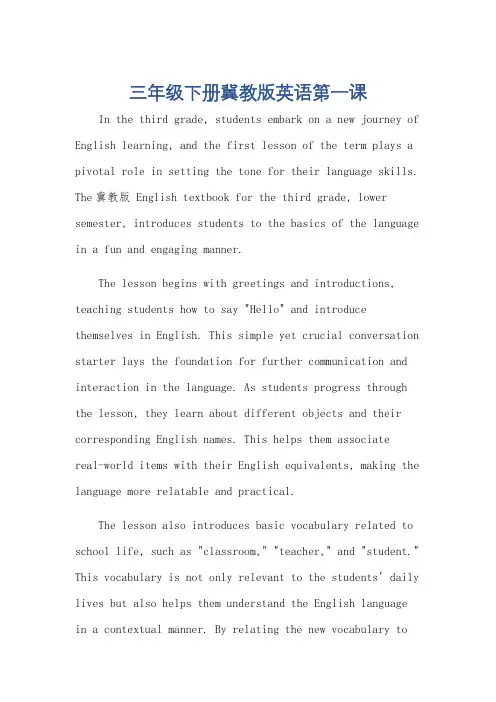
三年级下册冀教版英语第一课In the third grade, students embark on a new journey of English learning, and the first lesson of the term plays a pivotal role in setting the tone for their language skills. The冀教版 English textbook for the third grade, lower semester, introduces students to the basics of the language in a fun and engaging manner.The lesson begins with greetings and introductions, teaching students how to say "Hello" and introduce themselves in English. This simple yet crucial conversation starter lays the foundation for further communication and interaction in the language. As students progress through the lesson, they learn about different objects and their corresponding English names. This helps them associatereal-world items with their English equivalents, making the language more relatable and practical.The lesson also introduces basic vocabulary related to school life, such as "classroom," "teacher," and "student." This vocabulary is not only relevant to the students' daily lives but also helps them understand the English languagein a contextual manner. By relating the new vocabulary tofamiliar settings and situations, the lesson makes learning more meaningful and enjoyable.To further enhance the learning experience, the lesson includes various activities and games that engage students actively. These activities range from simple speaking exercises to more interactive role-playing games, allowing students to practice their English skills in a fun and dynamic environment. These activities not only improve students' language proficiency but also foster a positive attitude towards learning English.The冀教版 English textbook also emphasizes the importance of visual aids and illustrations in aiding learning. The lesson is accompanied by colorful images and diagrams that help students visualize the new vocabulary and concepts. This visual stimulation not only makes learning more engaging but also helps students retain information better.In addition to the basic language skills, the lesson also focuses on developing students' cultural awareness. It introduces them to basic etiquette and greetings inEnglish-speaking countries, helping them understand theimportance of respecting cultural differences. This focus on cultural understanding complements the language learning and prepares students for real-world interactions with people from different backgrounds.The third grade is a crucial phase in students' language development, and the first lesson of the冀教版English textbook for the lower semester sets the stage for successful English learning. By introducing students to the basics of the language in a fun and engaging manner, the lesson fosters a positive attitude towards learning that will carry them through their English learning journey. As students progress through the term, they will build upon the foundation laid in this first lesson, developing their language skills and cultural understanding to new heights. **冀教版三年级下册英语第一课:英语学习新篇章的开启** 三年级的学生们迎来了英语学习的新篇章,而本学期的第一课对于他们的语言技能发展具有举足轻重的意义。
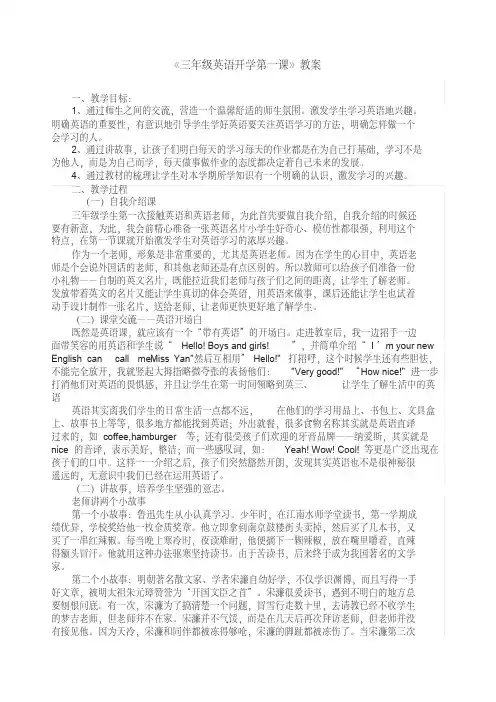
《三年级英语开学第一课》教案一、教学目标:1、通过师生之间的交流,营造一个温馨舒适的师生氛围。
激发学生学习英语地兴趣。
明确英语的重要性,有意识地引导学生学好英语要关注英语学习的方法,明确怎样做一个会学习的人。
2、通过讲故事,让孩子们明白每天的学习每天的作业都是在为自己打基础,学习不是为他人,而是为自己而学,每天做事做作业的态度都决定着自己未来的发展。
4、通过教材的梳理让学生对本学期所学知识有一个明确的认识,激发学习的兴趣。
二、教学过程(一)自我介绍课三年级学生第一次接触英语和英语老师,为此首先要做自我介绍,自我介绍的时候还要有新意,为此,我会前精心准备一张英语名片小学生好奇心、模仿性都很强,利用这个特点,在第一节课就开始激发学生对英语学习的浓厚兴趣。
作为一个老师,形象是非常重要的,尤其是英语老师。
因为在学生的心目中,英语老师是个会说外国话的老师,和其他老师还是有点区别的。
所以教师可以给孩子们准备一份小礼物——自制的英文名片,既能拉近我们老师与孩子们之间的距离,让学生了解老师。
发放带着英文的名片又能让学生真切的体会英语,用英语来做事,课后还能让学生也试着动手设计制作一张名片,送给老师,让老师更快更好地了解学生。
(二)课堂交流——英语开场白既然是英语课,就应该有一个“带有英语”的开场白。
走进教室后,我一边招手一边面带笑容的用英语和学生说“Hello! Boys and girls!”,并简单介绍“I’m your new English can call meMiss Yan"然后互相用”Hello!"打招呼,这个时候学生还有些胆怯,不能完全放开,我就竖起大拇指略微夸张的表扬他们:"Very good!"“How nice!"进一步打消他们对英语的畏惧感,并且让学生在第一时间领略到英三、让学生了解生活中的英语英语其实离我们学生的日常生活一点都不远,在他们的学习用品上、书包上、文具盒上、故事书上等等,很多地方都能找到英语;外出就餐,很多食物名称其实就是英语直译过来的,如coffee,hamburger等;还有很受孩子们欢迎的牙膏品牌——纳爱斯,其实就是nice的音译,表示美好,整洁;而一些感叹词,如:Yeah! Wow! Cool!等更是广泛出现在孩子们的口中。
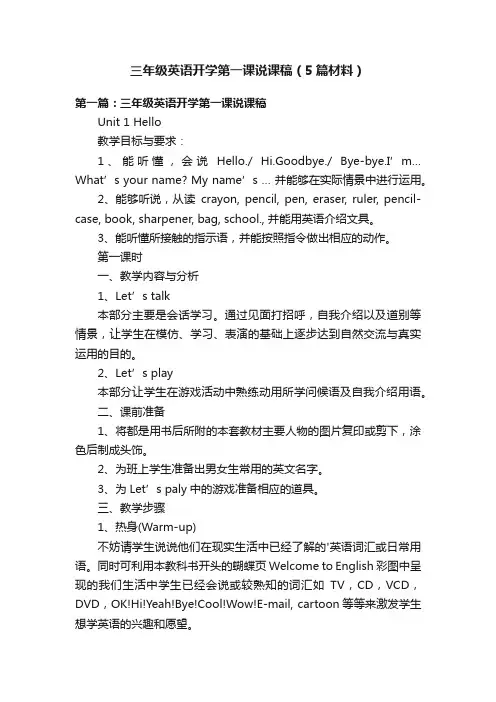
三年级英语开学第一课说课稿(5篇材料)第一篇:三年级英语开学第一课说课稿Unit 1 Hello教学目标与要求:1、能听懂,会说Hello./ Hi.Goodbye./ Bye-bye.I’m… What’s your name? My name’s … 并能够在实际情景中进行运用。
2、能够听说,从读crayon, pencil, pen, eraser, ruler, pencil-case, book, sharpener, bag, school., 并能用英语介绍文具。
3、能听懂所接触的指示语,并能按照指令做出相应的动作。
第一课时一、教学内容与分析1、Let’s talk本部分主要是会话学习。
通过见面打招呼,自我介绍以及道别等情景,让学生在模仿、学习、表演的基础上逐步达到自然交流与真实运用的目的。
2、Let’s play本部分让学生在游戏活动中熟练动用所学问候语及自我介绍用语。
二、课前准备1、将都是用书后所附的本套教材主要人物的图片复印或剪下,涂色后制成头饰。
2、为班上学生准备出男女生常用的英文名字。
3、为Let’s paly中的游戏准备相应的道具。
三、教学步骤1、热身(Warm-up)不妨请学生说说他们在现实生活中已经了解的'英语词汇或日常用语。
同时可利用本教科书开头的蝴蝶页Welcome to English彩图中呈现的我们生活中学生已经会说或较熟知的词汇如TV,CD,VCD,DVD,OK!Hi!Yeah!Bye!Cool!Wow!E-mail, cartoon等等来激发学生想学英语的兴趣和愿望。
2、新课展示(Presentation)教师播放本课的歌曲“Hello”的录音,自然引出师生之间的打招呼。
T: Hello, boys and girls.Ss: Hello, Miss? Mr….(1)、通过教师的自我介绍自然引出Hello, I’m… /HI, I’m…(2)、教师可戴上Sarah的头饰介绍Hello!I’m Sarah.并用同样方式介绍其他人物。
(人教PEP)三年级英语下册教案Unit 1 Welcome back to schoolLesson 1一、教学目标:1.巩固Good morning./ Hi.2.并学习新句型:We have a new friend today. I’m from …(国家)。
Welcome!3.通过教学会话,让学生学会介绍他人及做自我介绍。
二、教学过程:(一)热身/复习(Warm-up/Revision)播放英语歌“Hello”的录音。
师生之间互相打招呼,与学生进行日常对话。
(二)新课展示(Presentation)1.接着刚才的环节教师继续和学生对话,如班上有新同学,引入We have a new friend.如没有新同学就安排个学生戴上Amy的头饰,引出该句。
T:带领全班一起说Amy! Welcome!注意不要将Welcome的发音发错了。
2.教师戴上头饰,手中兴起中国的国旗,扮演Bai Ling:Hi, I’m Bai Ling. I’m from China.(手中挥动中国国旗)。
利用国旗卡片,教读China, America, Canada三国的名字。
3.教师通过放录音,贴挂图的方式来让学生感知对话。
并能利用头饰及老师提供的各国特殊物品作拟人式的自我介绍。
再进行介绍他人的操练。
(三)趣味操练(Practice)1.用“开火车”的形式请学生作自我介绍,教师引导全班向他/她问好。
表演对话内容。
2.鼓励学生用其他的著名人物或动物改编并表演对话。
3.分组进行议议,说说。
(四)课堂评价(Assessment)1.内容:活动手册P1。
目标:通过听力练习,检查学生对对话部分的理解和掌握情况。
老师可适当讲解题意。
正确一小题,可以涂一朵小花。
2. Story time部分(1)放录音,学生看书上的插图,理解故事。
特别是几个难句。
(2)再听录音,及观察教师的表演,并鼓励学生模仿故事人物的语气。
鼓励学生分角色表演故事。
新人教版小学三年级英语下册Unit 1 Welcome back to school!第一课时教案教学目标:知识与技能:能听说单词Welcome,back,boy, and,girl, we, new, friend, today, from等;会运用句子I’m /I’m from介绍自己及自己的情况。
过程与方法:创设情景,小组合作学习中巩固运用句型和单词。
情感、态度和价值观:培养学生尊重他人的良好品质。
教学重点、难点:理解单词boy,girl,friend。
1.boy和from的读音不易掌握。
2.认识和理解英语中人名、地名及国家名称的写法和读法。
教学过程:一、热身/复习(Warm-up/Revision)师生问候,用英语打招呼Welcome back to school!复习巩固学过的内容,创设英语学习氛围。
二、新课展示(Presentation)1.教师借助Amy和Zhang Peng的头饰向学生介绍引出单词:boy,girl,friend。
2.利用单词卡片教学生认读单词:boys and girls, today, new friends。
3.教师带头饰自我介绍:Hi,I’m Amy. I’m from the UK.借助国旗引导学生认识英国的英语名称。
4.教师带头饰自我介绍:Hi,I’m Zhang Peng. I’m from Shandong.借助国旗引导学生认识英国、美国和加拿大的英语名称。
5.教师点拨:英语中人名、地名和国家名称的首写字母大写的写法。
the UK是英文缩写形式必须都大写,读作U和K。
(6)听课文录音,跟读对话。
三、趣味操练(Practice)1.学生两人一组分角色练习对话。
2.小组展示:表演对话。
3. Look and say:看国旗,编对话运用句子:I’m /I’m from 介绍自己及自己的情况。
理解What about you?的含义。
Unit 1 Welcome back to school第一课时教学目标:1. 能听懂会说We have a new friend today. I'm from .... Welcome. 并能在实际情景中运用,要求模仿正确,语调自然。
2. 听说出几个国家的名称,如:America, Canada, China并了解相应的国家国旗。
3. 培养学生的爱国意识,对学生进行和平意识和世界意识的培养和熏陶。
【教学重点】句型:We have a new friend today. I’m from Amercia.词汇:welcome, America, Canada, China【教学难点】Welcome的发音。
【教具准备】1.准备Amy, Mike和Bailing的头饰。
2.教材相配套的教学课件[Unit 1 Let’s talk]。
3.教材相配套的教学录音带。
【教学过程】(一)热身/复习(Warm-up/Revision)1.复习第一册所学歌曲“Hello”。
[使用第一册Let’s sing/A部分配套录音带]2.对话练习:教师:Hello, A.学生:Hello,teacher.教师:Welcome back to school. Nice to see you again.学生:Nice to see you, too.请一些学生做此对话练习,由教师和一名学生来做,过渡到由两名学生来做。
(二)呈现新课(Presentation)1.师生问侯:教师:Good morning, boys and girls.学生:Good morning, teacher.教师:I’m Miss He. I’m from China.(手中举起中国国旗) And you?鼓励学生说出:I’m .… I’m from China.2.让更多的学生进行自我介绍:I’m .… I’m from .…3.教师:Class, we have a new friend today. 让学生观看教学课件。